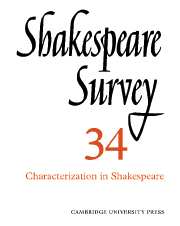Book contents
- Frontmatter
- Shakespeare’s Open Secret
- The Emergence of Character Criticism, 1774–1800
- Society and the Individual in Shakespeare’s Conception of Character
- Realistic Convention and Conventional Realism in Shakespeare
- On Expectation and Surprise: Shakespeare’s Construction of Character
- Shakespeare and the Ventriloquists
- The Rhetoric of Character Construction: Othello
- Characterizing Coriolanus
- The Ironic Reading of The Rape of Lucrece and the Problem of External Evidence
- The Unity of Romeo and Juliet
- No Abuse: The Prince and Falstaff in the Tavern Scenes of Henry IV
- Twelfth Night: The Experience of the Audience
- Plays and Playing in Twelfth Night
- Sceptical Visions: Shakespeare’s Tragedies and Jonson’s Comedies
- Shakespeare in Performance, 1980
- The Year's Contributions to Shakespearian Study 1 Critical Studies
- 2 Shakespeare’s Life, Times and Stage
- 3 Textual Studies
- Index
- Plate Section
Plays and Playing in Twelfth Night
Published online by Cambridge University Press: 28 March 2007
- Frontmatter
- Shakespeare’s Open Secret
- The Emergence of Character Criticism, 1774–1800
- Society and the Individual in Shakespeare’s Conception of Character
- Realistic Convention and Conventional Realism in Shakespeare
- On Expectation and Surprise: Shakespeare’s Construction of Character
- Shakespeare and the Ventriloquists
- The Rhetoric of Character Construction: Othello
- Characterizing Coriolanus
- The Ironic Reading of The Rape of Lucrece and the Problem of External Evidence
- The Unity of Romeo and Juliet
- No Abuse: The Prince and Falstaff in the Tavern Scenes of Henry IV
- Twelfth Night: The Experience of the Audience
- Plays and Playing in Twelfth Night
- Sceptical Visions: Shakespeare’s Tragedies and Jonson’s Comedies
- Shakespeare in Performance, 1980
- The Year's Contributions to Shakespearian Study 1 Critical Studies
- 2 Shakespeare’s Life, Times and Stage
- 3 Textual Studies
- Index
- Plate Section
Summary
‘The purpose of playing,’ says Hamlet, is ‘to hold as ‘twere the mirror up to nature: to show virtue her feature, scorn her own image, and the very age and body of the time his form and pressure.’ Hamlet himself employs ‘playing’, in various guises, as a means of penetrating false appearances to uncover hidden truths, but he also discovers how slippery illusions can be when their effects become entangled in the human world. Like Hamlet, but in a comic vein, Twelfth Night poses questions about ‘the purpose of playing’ and about whether illusion is perhaps too deeply embedded in human experience to be ever completely separated from reality.
Virtually every character in Twelfth Night is either an agent or a victim of illusion, and often a player will assume both these roles: as Viola is an impostor but also a prisoner of her own disguise, or as Sir Toby loses control of the deception he has contrived when he mistakes Sebastian for his twin. Illyria is a world populated by pretenders, which has led one critic to describe the action as 'a dance of maskers . . . for the assumption of the play is that no one is without a mask in the serio-comic business of the pursuit of happiness'. In the course of the story, many of these masks are stripped away or willingly set aside; but illusion itself plays a pivotal yet somewhat ambiguous role in this process.
- Type
- Chapter
- Information
- Shakespeare Survey , pp. 121 - 130Publisher: Cambridge University PressPrint publication year: 1982

